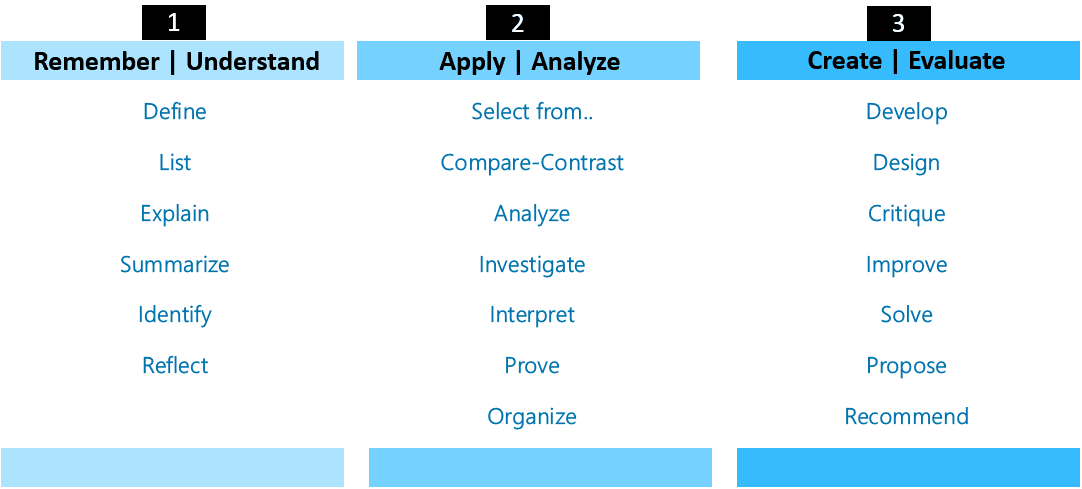Discussion Forums
Have Better Discussions Online than You Ever Had in the Classroom
Discussion forums are frequently used in online courses. In the online environment, you can ask better questions that promote critical thinking and give students the time to actually think through their ideas and responses to each other.
One common complaint about discussion forums is that they aren’t good substitutes for in-class discussion. That can sometimes be true, but they can still bring students together, document the collaborative experience, and make visible what everyone is thinking. The end result of forums can show how students’ experiences and thoughts intersect and come together to form new knowledge.
The most important element to consider when designing discussion forums that promote good student interaction is your question/prompt. The following prompt would result in very poor discussion/interaction between students because all students will be posting virtually the same information. Quite frankly, there’s nothing to talk about!
Summarize this week’s reading and post it to the discussion board.
This prompt would be more appropriate as an assignment that each student completes individually.
So how do you build a good discussion prompt?
Define Discussion Prompt Levels and Objectives
Discussion prompts must be constructed with the following considerations:
Objective: What is the purpose of the discussion? What are students contributing individually? What do they need to contribute with others in the class?
Difficulty level: At what level should the discussion be? Do they simply read something and recall the information? Are they thinking deeper with analysis and creating new ideas from what they know?
Prior knowledge: What do they know coming into the discussion? Are they ready for the difficulty level you intend?
Interaction sequence: How long should the discussion flow? Should it be a simple post-reply interaction? Should the interaction be deeper into uncovering new or common thinking among the class? Will it take them a few minutes or a few days?
As you create the discussion prompts, keep in mind Bloom’s taxonomy levels.

Structure of a Discussion Forum
Detailed instructions, provided within each forum, explain how students should post and interact with peers.
-
Write instructions on what students must contribute to the discussion.
- What to post
- How to post
- Deadline (Date and Time)
- Length (e.g. 350 words, 1-2 paragraphs)
Here is an example.
Initial Post
Create your post, per the prompt/questions above. Discuss your ideas in a thoughtful but brief and focused paragraph. Make an effort to create as an original post as possible, which means read your classmates’ posts before you post. Post your response by Tuesday, 11:59PM.
-
Write instructions on what students should collaborate on with classmates.
- How to reply
- Number of Responses
- Deadline (Date and Time)
- Length (e.g. 70 words, 1-2 paragraphs)
- Extensions to other discussion forum
Here are two examples.
Reply Post/Add Something to Your Classmate’s Idea
Reply to two of your classmates’ posts by Thursday, 11:59 PM. Each reply should be a brief but thoughtful paragraph. You cannot just say “I agree.” “Interesting post.” “Good idea.” Support your statements with examples, experiences, or references. Make sure you address the subject of your classmates’ thread.
Consolidate common ideas
As a class / group, consolidate the common ideas that were generated. Reflect on how similar or different your response was to the rest of the class. Post these ideas in the second discussion forum by Thursday, 11:59 PM.
Prompting Student Responses
For some students, this may be their first online course. They may not know how to articulate their ideas and respond to others. In addition, some students may need help with their social skills when interacting online. The following link provides sentence starters which will help everyone to promote an engaging discussion.
Prompting Student Responses [PDF, 189 KB]
Grading Discussions
Grading rubrics or checklists should be provided with each forum. These detailed scoring guides provide students with additional direction as they discuss topics. Consider adding the following components to your rubric or checklist.
Critical Analysis:
- Discussion posts should display an excellent understanding of the assigned readings/content with clear integration of new information with old beliefs or understandings of topics.
- Posts should clearly address provided questions.
- Posts should provide appropriately cited evidence from the readings to support important points.
Interaction:
- Reply posts should be posted throughout the length of the discussion and not all at the beginning or end.
- Reply posts should further discussion by asking thought-provoking questions, and/or presenting affirmative or oppositional statements with evidence or real-world experience to support the claim.
- Questions from the instructor or peers are answered throughout the length of the discussion.
Quality of Writing:
- Posts should be free of grammatical errors and carefully proofread.
- All posts should begin with a greeting and close with poster’s name.